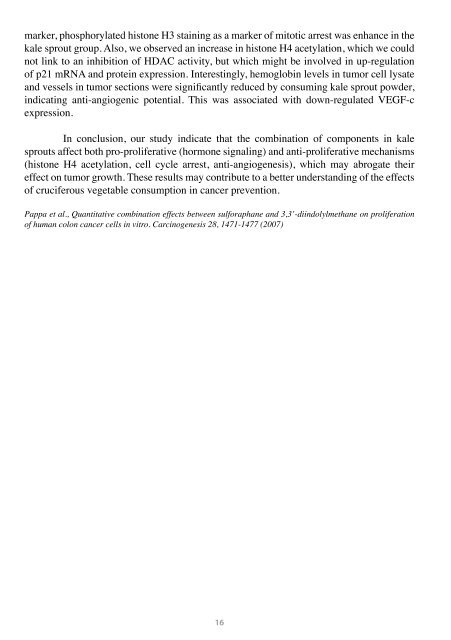Cancer Research Institute, Slovak Academy of Sciences
Cancer Research Institute, Slovak Academy of Sciences
Cancer Research Institute, Slovak Academy of Sciences
You also want an ePaper? Increase the reach of your titles
YUMPU automatically turns print PDFs into web optimized ePapers that Google loves.
marker, phosphorylated histone H3 staining as a marker <strong>of</strong> mitotic arrest was enhance in the<br />
kale sprout group. Also, we observed an increase in histone H4 acetylation, which we could<br />
not link to an inhibition <strong>of</strong> HDAC activity, but which might be involved in up-regulation<br />
<strong>of</strong> p21 mRNA and protein expression. Interestingly, hemoglobin levels in tumor cell lysate<br />
and vessels in tumor sections were significantly reduced by consuming kale sprout powder,<br />
indicating anti-angiogenic potential. This was associated with down-regulated VEGF-c<br />
expression.<br />
In conclusion, our study indicate that the combination <strong>of</strong> components in kale<br />
sprouts affect both pro-proliferative (hormone signaling) and anti-proliferative mechanisms<br />
(histone H4 acetylation, cell cycle arrest, anti-angiogenesis), which may abrogate their<br />
effect on tumor growth. These results may contribute to a better understanding <strong>of</strong> the effects<br />
<strong>of</strong> cruciferous vegetable consumption in cancer prevention.<br />
Pappa et al., Quantitative combination effects between sulforaphane and 3,3’-diindolylmethane on proliferation<br />
<strong>of</strong> human colon cancer cells in vitro. Carcinogenesis 28, 1471-1477 (2007)<br />
L7<br />
NOVEL TARGETS OF DIETARY ISOTHIOCYANATES IN CANCER<br />
PREVENTION<br />
Bao, Y.<br />
School <strong>of</strong> Medicine, Health Policy and Practice,University <strong>of</strong> East Anglia, UK<br />
y.bao@uea.ac.uk<br />
Epidemiological studies suggest that a diet rich in cruciferous vegetables is<br />
associated with a decreased risk <strong>of</strong> many common cancers. Their protective effects are<br />
attributed, at least in part, to isothiocyaniates, the breakdown products <strong>of</strong> glucosinolates.<br />
Many studies have demonstrated that isothiocyanates can modulate multiple cellular<br />
targets including phase I carcinogen-activating enzymes, phase II detoxification enzymes,<br />
cell cycle arrest and apoptosis.<br />
Recent studies suggest that sulforaphane can upregulate sequestosome p62 and<br />
induce autophagy (cellular self-eating). p62 is a common component <strong>of</strong> protein aggregates<br />
associated with protein misfolding diseases and play an important role in the life and death<br />
decisions <strong>of</strong> the cell. Interestingly, we have shown that sulforaphane can induce Nrf2 translocation<br />
into nucleus and increase p62 expression in human hepatocytes. Therefore, we<br />
speculate that this stimulation <strong>of</strong> the Nrf2 pathway by sulforaphane and consequent increase<br />
in p62 could facilitate targeting <strong>of</strong> damaged cellular components to autophagosomes and<br />
play a role in cancer prevention.<br />
Furthermore, we have shown that sulforaphane can down-regulate COX-2<br />
expression in colon and bladder cancer cells. Moreover, we have established that<br />
synergistic interactions occur between isothiocyanates and mineral selenium in the<br />
regulation <strong>of</strong> antioxidant gene expression including thioredoxin reductase (TR1) and<br />
gastrointestinal glutathione peroxidase (GI-GPx).<br />
Very recently, we have found that sulforaphane down-regulated the expression<br />
<strong>of</strong> serotonin receptors and serotonin reuptake transporter (SERT), promoting signals for<br />
serotonin release by mediating G-proteins and activating neurotransmitter receptors, which<br />
are important in the proliferation <strong>of</strong> colon cancer cells.<br />
In summary, the effect <strong>of</strong> sulforaphane on the expression <strong>of</strong> p62, COX-2 and<br />
neurotransmitter receptors may provide new insights into the development <strong>of</strong> strategies that<br />
utilize dietary isothiocyanates for cancer prevention.<br />
16 17


